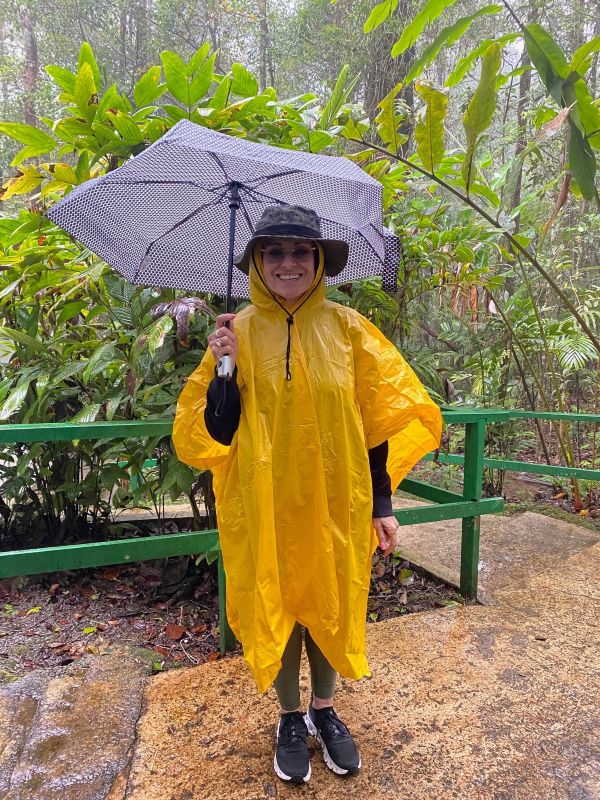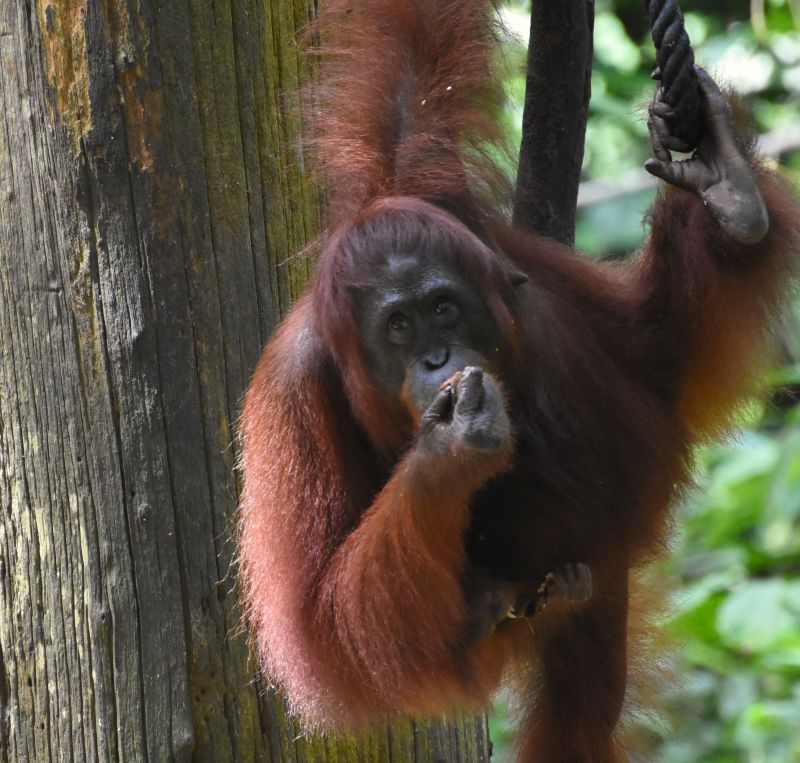For twenty-four years, I dreamed of visiting Borneo. I even had it listed on my Bucket List. While I ticked off other items on my list during that time—some as remote and hard to get to as Borneo—I still put it off thinking it was too way off the beaten track and likely too third-worldly. Clearly, many people have never heard of Borneo—the world’s third-largest island—and there’s no judgement on my part. I had never heard of it until my husband and I vacationed in Bali in 2000, where we met a young man named Made working at the resort where we stayed. He hailed from a small village in Borneo (also known as Kalimantan in the Indonesian language), and he plied us with remarkable stories from his native land. The moment he mentioned it was the home of the orangutans, I knew I had to visit one day.

Borneo is situated east of Malaysia, southwest of the Philippines and northeast of Indonesia. The island is divided among three countries—Malaysia and Brunei in the northwest, and Indonesia to the southeast (the Indonesian side takes up 73 percent of the island). While my original desire was to visit Indonesian Kalimantan, where Made was from, I was encouraged by my travel consultant to opt for Malaysian Borneo, which offered more options for tourism.
As I wrote in last month’s blog—in which I covered this trip’s first leg in Singapore—I promised to share my incredible adventure in Borneo. It began on Sunday, October 20 and lasted for 10 glorious days, each one exceeding the previous day. Still, before I arrived on the island, I had no specific expectations except to see orangutans in the wild. That’s akin to saying I only expected to see elephants on an African safari. As I learned, there are eight species of apes that are only found in Borneo. Add to that the native birds and other unique mammals (flying squirrels, anyone?) and it’s a nature lover’s paradise.
Other Worldly, Not Third Worldly
Leaving ultra-modern Singapore—known for its cleanliness, safety and being an international banking hub—for what many call a third-world country—Malaysia—I was a bit concerned. I have been to many such countries and most had areas that were patently unsafe with visible signs of poverty. I hoped Borneo wasn’t that way. Arriving at the capital city of Kota Kinabalu, I was duly impressed with its beautiful, new airport. Nothing third world about it. LAX should take note. Although it was dark and drizzling by the time I got to the hotel, I saw no visible signs of poverty anywhere.

Even though my colorful, picture-filled itinerary specified everything I should expect to see at the four different lodges I’d be staying at in the various rainforests of Borneo, I was unprepared for the onslaught of incomparable beauty of the flora and variety of fauna I’d encounter. Not only the plethora of mammals, birds, reptiles and insects I’d see during the day, but on night walks, I’d encounter nocturnal creatures not visible diurnally.
Early the next morning, my guide Stephanie and our driver took me to Kinabalu National Park, home to the country’s highest mountain, Mount Kinabalu (13,435 feet). After being caught in a heavy downpour during our visit to the Botanical Garden, we enjoyed the swaying challenge of traversing Poring Hot Springs’ canopy treetop walk under the shade of numerous Menggaris (Kompassia excelsa) trees. The day was capped off with a local lunch of fresh chicken, rice and vegetables and soaking my tired feet in the hot sulfur water of the tubs at the springs.
A short flight the next morning to Sandakan—on the northeastern tip of Borneo—got me closer to the wilderness I sought, which included the orangutans. But it’d be a couple more days till that happened. At My Nature Resort, I admired the profusion of uniquely shaped bougainvillea flowers in various colors bordering the pool area then swam and lounged there a bit after lunch. While the bold pig-tailed macaques strode though the property about 4:00 PM as if they owned it, searching for food and anything else they could steal, I was then entertained by a couple of red giant flying squirrels adjacent to the dining area at dusk. After gorging myself on fresh cooked meats, fish, vegetables and rice at the abundant buffet, I was treated to a guided night walk where I discovered a variety of creatures that only appear in the dark: an Arapaima gigas fish in the creek, fruit bats, giant forest ants, stick insects, Huntsman spiders along the walkway, and the echoing sounds of tree frogs in the nearby foliage.
Orang Utan
Having already gotten a substantial taste of the flora and fauna in this part of Sandakan, I was looking forward to the half-hour speed boat ride the following morning, which would take me deeper into the jungle. This is what I came for, a boundless wildlife adventure with surprises at every turn. This morning was spent at both the Sepilok Orang Utan Rehabilitation Centre as well as the Bornean Sun Bear Conservation Centre, which rehabilitates sun bears who’d been abused in captivity, spreading awareness about their conservation. So, on Day 6 of my trip, I was finally going to see the orangutans, albeit in a restricted area.

Recalling my experience trekking in the Ugandan rainforest 11 years ago where I was able to view a family of mountain gorillas, I wasn’t surprised when I was told human visitors must keep a distance of at least 15 feet from the orangutans (it was the same with the gorillas). Because the red-haired apes share 97 percent of their DNA with humans, they could be susceptible to any viruses or diseases we may be carrying. The only close call came when a mother with her baby clinging to her back seemed to appear out of nowhere, sashaying on the walkway’s railing as a group of us tourists made our way to the viewing area. She and her baby had likely gotten too close to us, but security immediately stepped in and allowed them to move forward without incident.
I was in heaven seeing these magnificent apes play, eat and groom right in front of me and I lost track of how many dozens of images I took with both my Nikon and iPhone. It’s other-worldly to experience these creatures, who are the most solitary of the great apes. Unlike the macaques, proboscis and other monkeys, who live communally, orangutans’ social bonds occur primarily between mothers and their dependent offspring. They spend most of their time in trees, building new nests in different trees every night to avoid predators and other (annoying) monkeys.
Conservation efforts of all kinds by both the Malaysian government and non-governmental organizations impressed me very much. And once again, not something one would expect from an “emerging” country. Stay tuned for the conclusion of my adventure in my January blog.


